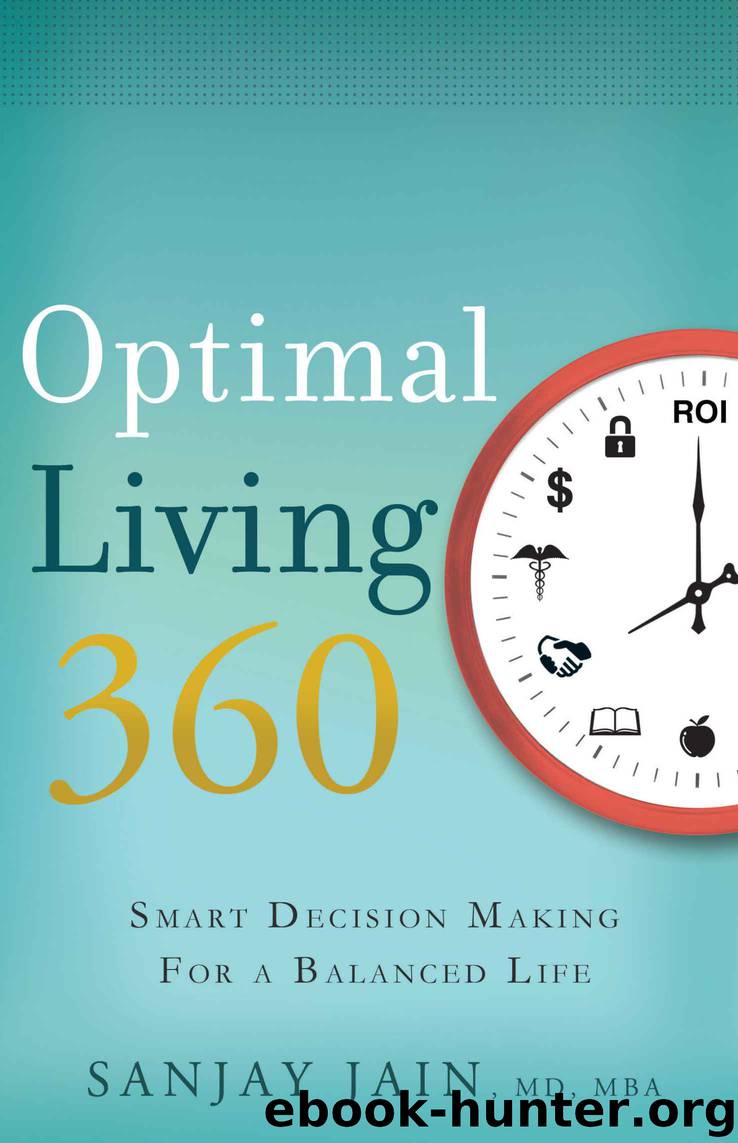Optimal Living 360: Smart Decision Making for a Balanced Life by Sanjay K. Jain

Author:Sanjay K. Jain [Jain, Sanjay K.]
Language: eng
Format: epub
ISBN: 9781608325849
Publisher: Greenleaf Book Group Press
Published: 2014-01-30T00:00:00+00:00
MENTAL REST IS BEST, GET YOUR SLEEP
Now, with all those new things to study all the time, you could go on forever nonstop, right? Wrong! Just as you’d need to take time to recuperate after running a marathon or rest up after a regular day of going to work, shopping, or other tasks, if you don’t get enough sleep, your mind will be compromised. Sleep hits the “reset” button in your brain. No matter how energetic you are, sleep is a vital component to your well-being and ability to be effective.
Busy people sometimes say they wish they didn’t have to sleep. Some even think sleeping is being lazy or wasting time. We might as well just get used to it—there’s no getting around the need for sleep. You might take an energy shot or fill up on coffee on occasion, but you can’t pull all-nighters forever.
Here’s a thought worth pondering: getting enough sleep is ultimately a time saver rather than a time waster. A well-rested person will get more done—and in much finer fashion—than a sleepy, over-caffeinated person trying to push through.
The next time you berate yourself for wanting to sleep for eight hours, consider your pet cat. Our feline friends sleep twelve hours a day. Don’t have a cat? Your dog snoozes ten hours every day. But the sleeping champion is the bat—they customarily nod off for a whopping twenty hours every day!
Perhaps you aspire to be a giraffe and sleep only three or four hours a day.
Those of you who think you’re doing nothing while asleep will be interested to know that the body is actually taking care of a lot of business during this most important time. REM sleep— the time associated with dreaming—is the stage most often talked about. However, 75 to 80 percent of sleep is non-REM. During that time breathing decreases, as does the blood pressure, and the heart slows down as well. This non-REM stage is broken down further into four stages—two periods of light sleep and two periods of deep sleep. During these latter two stages of non-REM, growth hormone and the all-important interleukins for building the immune system are released.
REM sleep takes up the other 20 to 25 percent of the sleep cycle. During this time, there is intense mental activity. Breathing, blood pressure, and heart rate all speed up again while the skeletal muscles go into a state of paralysis. When you wake up and remember you’d just been flying or driving a bus through the streets of ancient Rome, or that you had gone to chemistry class and suddenly realized you’d forgotten your pants, you are recalling the dream times that occur during the REM stage.
Together these stages make up one sleep cycle that lasts about ninety minutes. Most adults ideally should get in four to six sleep cycles nightly, or seven to nine hours of sleep. The amount of sleep needed varies somewhat and is determined by each person’s genetic makeup, but few people function well on less than six hours.
Download
This site does not store any files on its server. We only index and link to content provided by other sites. Please contact the content providers to delete copyright contents if any and email us, we'll remove relevant links or contents immediately.
| Ethics | Etiquette |
| Fashion & Image | Health & Stress |
| Motivation & Self-Improvement | Work Life Balance |
| Workplace Culture |
Tools of Titans by Timothy Ferriss(8303)
Change Your Questions, Change Your Life by Marilee Adams(7676)
Deep Work by Cal Newport(6961)
Playing to Win_ How Strategy Really Works by A.G. Lafley & Roger L. Martin(6074)
Man-made Catastrophes and Risk Information Concealment by Dmitry Chernov & Didier Sornette(5951)
Digital Minimalism by Cal Newport;(5698)
Big Magic: Creative Living Beyond Fear by Elizabeth Gilbert(5674)
The Slight Edge by Jeff Olson(5376)
Ego Is the Enemy by Ryan Holiday(5343)
The Motivation Myth by Jeff Haden(5174)
The Laws of Human Nature by Robert Greene(5072)
Stone's Rules by Roger Stone(5050)
Tuesdays with Morrie by Mitch Albom(4727)
Eat That Frog! by Brian Tracy(4479)
Rising Strong by Brene Brown(4409)
Skin in the Game by Nassim Nicholas Taleb(4200)
Bullshit Jobs by David Graeber(4136)
The Money Culture by Michael Lewis(4127)
Skin in the Game: Hidden Asymmetries in Daily Life by Nassim Nicholas Taleb(3960)
